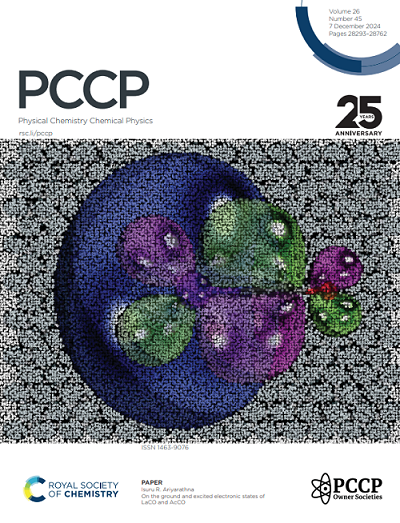Understanding the Excited State Decay Mechanism of Complex Systems: A General First-Order Kinetic Model
IF 2.9
3区 化学
Q3 CHEMISTRY, PHYSICAL
引用次数: 0
Abstract
In this work, we have proposed and evaluated a first-order kinetic model to describe the excitedstates dynamics of molecules as a computationally cheaper alternative to describe and understand the photophysical profile of large systems. The method is based on calculating the radiative and nonradiative rate constants of all photophysical processes of a collection of crucial low-lying excited states and modeling the decay over time using a first-order kinetic model. We have successfully applied the method to the [Ru(bpz)3]2+ (bpz = 2,2’-bipyrazyl) complex as a case study, obtaining good results. By employing this first-order kinetic model, it is possible to simulate the time-dependent decay process and the evolution of the excited-state population, revealing not only the primary deactivation pathway but also secondary states that contribute to the overall decay mechanism, highlighting alternative channels that may lead to photochemical side products. This approach provides a computationally efficient yet accurate method for studying more intricate systems relevant to photoinduced processes. It enhances the understanding of these compounds and offers guidance for fine-tuning their chemical and structural properties for targeted applications.理解复杂系统的激发态衰减机制:一个通用的一阶动力学模型
在这项工作中,我们提出并评估了一种一阶动力学模型来描述分子的激发态动力学,作为一种计算成本更低的替代方法来描述和理解大型系统的光物理剖面。该方法是基于计算一系列关键低洼激发态的所有光物理过程的辐射和非辐射速率常数,并使用一级动力学模型模拟随时间的衰减。我们已经成功地将该方法应用于[Ru(bpz)3]2+ (bpz = 2,2 ' -联吡唑)配合物的研究中,获得了良好的结果。通过采用这一一级动力学模型,可以模拟随时间变化的衰变过程和激发态种群的演变,不仅揭示了初级失活途径,还揭示了有助于整体衰变机制的次级状态,突出了可能导致光化学副产物的替代通道。这种方法为研究与光诱导过程相关的更复杂的系统提供了一种计算高效而准确的方法。它增强了对这些化合物的理解,并为微调它们的化学和结构特性提供了指导。
本文章由计算机程序翻译,如有差异,请以英文原文为准。
求助全文
约1分钟内获得全文
求助全文
来源期刊

Physical Chemistry Chemical Physics
化学-物理:原子、分子和化学物理
CiteScore
5.50
自引率
9.10%
发文量
2675
审稿时长
2.0 months
期刊介绍:
Physical Chemistry Chemical Physics (PCCP) is an international journal co-owned by 19 physical chemistry and physics societies from around the world. This journal publishes original, cutting-edge research in physical chemistry, chemical physics and biophysical chemistry. To be suitable for publication in PCCP, articles must include significant innovation and/or insight into physical chemistry; this is the most important criterion that reviewers and Editors will judge against when evaluating submissions.
The journal has a broad scope and welcomes contributions spanning experiment, theory, computation and data science. Topical coverage includes spectroscopy, dynamics, kinetics, statistical mechanics, thermodynamics, electrochemistry, catalysis, surface science, quantum mechanics, quantum computing and machine learning. Interdisciplinary research areas such as polymers and soft matter, materials, nanoscience, energy, surfaces/interfaces, and biophysical chemistry are welcomed if they demonstrate significant innovation and/or insight into physical chemistry. Joined experimental/theoretical studies are particularly appreciated when complementary and based on up-to-date approaches.
 求助内容:
求助内容: 应助结果提醒方式:
应助结果提醒方式:


